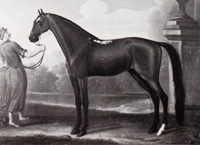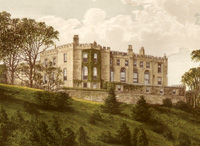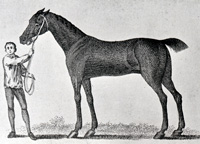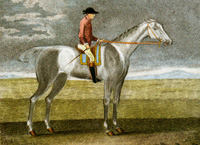|

Courtesy of the
Grimsthorpe
and
Drummond Castle Trust

Courtesy of H Culwen
Workington Hall, Cumberland

Sire Line

Curwen's Bay Barb


Brocklesby Betty, by
Curwen's Bay Barb

Creeping Molly,
by Curwen's Bay Barb
|
Curwen's Bay Barb
b c 1681c [Pelham's Bay Barb]. Sire
Line Curwen's
Bay Barb.
Highflyer
speculates that Curwen's Bay Barb was the same horse as
the Taffolet Barb and the Lowther Bay Barb. One of the most
influential imported eastern stallions, he was probably of equal
importance to the establishment of the stud book as were the
Byerley
Turk, the Darley Arabian,
and the Godolphin Arabian.
William Pick noted that his celebrity was such that he was
referred to simply as the Bay Barb, as if no other barb of that
colour had ever stood in England. Cheny (1747) wrote that the
Bay Barb and the Thoulouse Barb were imported by Henry
Curwen. "That Gentleman being in France at a time when
Count Byram and Count Thoulouse (two natural Sons of
Lewis the Fourteenth) were, the former, Master of the
Horse, and the other an Admiral, he procured of them two
Barb Horses, which he convey'd to England."
Louis XIV had a number of illegitimate children,
including Louis Alexandre, Comte de Toulouse, who at one
time did hold the rank of admiral. But no trace can be
found of a son titled Count Byram, much less one who was
master of the horse (called in France “Grand Écuyer” or
simply “Monsieur le grand”). From 1677 to 1712, the
Grand Écuyer was Henri de Lorraine, Comte de Brionne – a
name which, by eighteenth-century spelling standards, is
quite similar to Byram. Although Brionne was not a son
of the king, he was indeed a count and, even more
significantly, he was master of the horse. It is almost
certain that, by virtue of his office, Brionne’s
knowledge and cooperation would have been required for
the removal of any horses from the French royal stud.
One theorist therefore hypothesizes that English writers
such as Cheny (who was based in Yorkshire) accidentally
substituted Byram, a name with which they were naturally
more familiar, for Brionne.
Another theorist believes that Byram is truly the
correct spelling and proposes the following scenario … According to J B
Robertson ("Mankato"), Henry Curwen was one of the
followers of King James II who accompanied him when he fled to
France in 1688 [Robertson:33], where he remained until around
1698. It seems likely that Curwen purchased the Bay Barb after
his arrival in France and had him sent to England around 1689.
Highflyer
speculates that since a diligant search unearthed no
such person as Count of Byram, allegedly a son of the
French king, that the Byram in question may have been
Sir William Ramsden (1672-1736), 2nd Baronet of Byram,
near Ferrybridge, Yorkshire.
Mr Prior notes that
"Sir William [Ramsden] married a daughter of John Lowther
(1655-1700), 1st Viscount Lonsdale, who himself lived some time
at Byram, and no doubt brought the Eastern-bred mares with him
from Lowther" [Early Records:125]. The Thoulouse Barb, also
purchased by Mr Curwen, may have travelled with the Barb on his trip to
Curwen's stud at Workington Hall, near Whitehaven in Cumberland. Curwen's Bay Barb is
sometimes referred to by the General Stud Book as the
"Curwen or Pelham Bay Barb". Charles Pelham, an
associate of Curwen's, may have stood the Barb at his Brocklesby
Park stud in Lincolnshire since Curwen, a Roman Catholic, was
subject to the law that forbade Catholics to own horses valued
at more than £5.
In any case he first made
his mark as a stallion based on the turf achievements of his
offspring. The stud book makes note of his runners, mentioning
the Mixbury Galloway and Tantivy, said to be very high-formed
galloways. Brocklesby and Little George were said to be in good
forms, and Yellow Jack, Bay Jack, Monkey, Dangerfield, Hip,
Peacock and Flatface in middling forms. Two brothers to Mixbury
were described as middling galloways, presumably distinguished
by their small size. The mares Long Meg, Brocklesby Betty and
Creeping Molly were noted as extraordinary high-formed mares,
while Whiteneck, Mistake, Sparkler and Lightfoot were said to be
very good mares. Not all of these runners left stock that bred
on, and some of his best breeding stock never saw a racecourse.
In the stud his sons were less
noteworthy than his daughters, with Hip (gr c 1716)
probably the best of them. Although at the time Brocklesby
Betty was probably the most famous of his daughters,
eventually Sister 1 to Mixbury was probably the most
influential, via her famous son Partner,
sire of numerous excellent daughters and grandsire of
King
Herod.
Curwen's Bay Barb was said
to have lived to the remarkable age of thirty-eight, and to have
stood for his portrait at the age of twelve. Although Henry
Curwen died in 1725, and made provisions in his will for a
number of his broodmares, no mention was made of the Barb [ER:146]. He probably died at Brocklesby Park around 1719.
| Curwen
Barb Mares |
| 1. |
Brocklesby
Betty (ch f 1711), attained much celebrity on the
turf, ranking among the finest of her day, as well as
serving as a foundation mare of
Family
23. |
| 2. |
Curwen Bay Barb
Mare, taproot of Family
36, was the grandam of
Engineer
(b c 1756 Sampson), who sired
Mambrino (gr c 1768).
Curwen's Bay Barb appears three times in the pedigree of
Mambrino. |
| 3. |
Sister 1 to Little
George was the 2nd dam of Meynell (ch f 1736
Partner),
taproot of Family
12-c, and the 3rd dam of Diana (f 1754
Cullen
Arabian), taproot of
Family
12-b. |
| 4. |
Sister
1 to Mixbury, taproot of
Family
9-a, was the dam of Croft's
Partner (ch c 1718 Jigg),
a Champion Sire four times, and one of the most
influential of the early sires, especially through his
son Tartar (ch c
1743), who sired King Herod
(b c 1758). Her daughter Miss Jigg (f 1717
Jigg)
was the dam of Mab (gr f 1740 Crab),
taproot of Family 9-d.
Her son, Soreheels (c
1720 Basto), sired the dam of
the good stallion South
(b c 1750 Regulus). Sister to
Soreheels was the dam of the Champion Sires
Devonshire
Blacklegs (br c 1728 Childers)
and Crab (gr c 1722 Alcock's
Arabian), as well as a number of other excellent
offspring. |
| 5. |
Sister
2 to Mixbury, was the dam of the Bolton Sloven
(br c 1718 Bay Bolton) who
sired Young Coquette (br f 1734), a useful Irish mare
from Family 44.
Sister to Sloven was the dam of both Crab Mare, taproot
of Family 9-c,
and Bolton Sweepstakes Mare, taproot of
Family
9-b. Sister 2 to Mixbury was also the dam of
Stanyan's Arabian Mare, ancestress of
St.
George (b c 1789 Highflyer),
who sired the Derby winner Pan (ch c 1805). |
| 6. |
Sister
to Westbury was the 3rd dam of
Wyvill's
Volunteer (b c 1725
Young
Belgrade) and his two sisters who helped establish
Family
18. |
| 7. |
Whiteneck
[Frampton's], a full-sister to the Mixbury Galloway and
Chedworth's Monkey, lost a 200 guineas match to Lord
Hervey's Wenn at Newmarket in May of 1710. She was the
3rd dam of Bay Snip (b f 1748
Snip)
and a contributor to Family
9. |
| 8. |
Sister to Witty's
Mare was the dam of the Ringtail Galloway (b f 1727
Hip), the latter the 5th dam of Bob Booty (ch c 1804
Chanticleer). See Hip, below.
Ringtail Galloway was inbred 2x2 to Curwen's Bay Barb. |
| |
| Other Notable
Offspring |
|
|
|
Creeping
Molly (GB) |
| gr f 1700 (Curwen's Bay Barb - Lowther
White-Legged Barb [Little Mountain Barb] - Foreign
Mare). Sire Line
Curwen's
Bay Barb. Bred by Sir
Michael Warton, Molly won Royal
Plates for five year old mares at Black Hambleton and
Newmarket in 1705 and several matches afterwards. She was probably the dam of the stallion
Warton's Commoner (gr c 1710c Crofts's Commoner).
Molly's dam was bred by Henry Curwen. Commoner sired the
dam of Chedworth's Grey Childers (gr c 1726
Childers),
and the dam of a Sultan Mare, the latter the dam of the
racehorse Grenadier (b c
1746 Blaze) and
possibly of Jenny Cameron* (b f 1742 Quiet Cuddy),
ancestress of the great American racehorse and stallion
Boston
(ch c 1833 Timoleon),
himself the sire of Lexington
(b c 1850). |
| |
|
Hip (GB) |
| [Pelham's] gr c 1716 (Curwen's Bay Barb - Sister to Piping Peg,
by Lister Turk). Sire Line
Curwen's
Bay Barb. Family 23. Bred by Charles Pelham, Hip was a notable broodmare sire. Hip
Mare produced the King's Plate winner,
Sampson
(b c 1745 Blaze), who
sired the first St Leger winner, Allabaculia (br f 1773), and
the good stallion, Engineer
(b c 1756), who numbered Mambrino
(gr c 1768) among his offspring. Another Hip mare (gr f 1733),
a half-sister to Babraham (b c 1738
Godolphin
Arabian), was the dam of Regulus Mare (gr f 1753), the
taproot of Family 15-d.
Hip Mare (ch f 1730) was the 2nd dam of the Doncaster Cup
winner Liberty (br c 1764). Ringtail Galloway (b f 1727) was
the 5th dam of the good Irish stallion Bob Booty (ch c 1804),
who in turn sired the dam of the famous
Birdcatcher
(ch c 1833 Sir Hercules). |
| |
|
Mixbury
Galloway (GB) |
| c 1704c (Curwen's Bay Barb - Mare, by
Curwen's Spot). Sire Line
Curwen's
Bay Barb. Family 9. He was bred by Curwen & Pelham from their Old Spot Mare.
Later owned by Richard Minshull of Bourton, Buckinghamshire, he
was called the Minchell or Minshull Galloway, although he
apparently derived his traditional name from the nearby village
of Mixbury in which his training ground was located. Described
as standing only thirteen hands two inches, he was said to be
unbeatable at light weights by all but one or two. He left two
daughters who exerted some influence. Mixbury Galloway Mare was
the 5th dam of Tipple Cyder (ch f 1788 King
Fergus), the taproot mare of
Family
8-k. Mixbury Galloway Mare was also the dam of Bay Ranger
(b c 1749), sire of Mr Hutton's Arbitrator (c 1766) whose
daughter contributed to Family
34. The other Mixbury Galloway Mare was the 5th dam of the
good American stallion Macklin's Fearnought (b c 1777
Fearnought*). |
| |
|
Monkey (GB) |
| [Chedworth's] c 1705c (Curwen's Bay Barb - Mare, by Curwen's
Spot). Sire Line Curwen's
Bay Barb. Family 9. Bred by Curwen & Pelham from their Old Spot Mare, he was
later owned by John Howe, 1st Baron Chedworth, one of two
brothers to Mixbury, of whom the stud book says one was
"used as a stallion, and sometimes called Monkey"
[GSB 1:17]. His daughter Little Bowes was the 2nd dam of the
useful stallion Silvio (b c 1754 Cade),
the 5th dam of the St Leger winner Tartar (ch c 1789
Florizel), and ancestress of such horses as Two Thousand Guineas
winners Petronel (br c 1877 Musket) and Vauban (br c 1864
Muscovite), and Prix du Jockey Club winner Champaubert (b c
1893 Little Duck). Another daughter, Monkey Mare, was the 3rd
dam of the stallion Meteor (ch c 1783
Eclipse),
who sired the Oaks winner Meteora (b f 1802). |
| |
|

